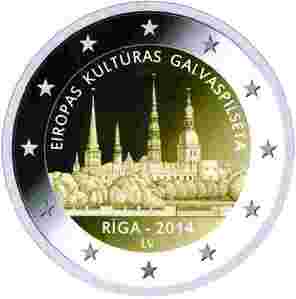EUR-Lex Access to European Union law

This document is an excerpt from the EUR-Lex website
Document C2014/088/03
New national side of euro coins intended for circulation
New national side of euro coins intended for circulation
New national side of euro coins intended for circulation
OJ C 88, 27.3.2014, p. 6–6
(BG, ES, CS, DA, DE, ET, EL, EN, FR, HR, IT, LV, LT, HU, MT, NL, PL, PT, RO, SK, SL, FI, SV)
|
27.3.2014 |
EN |
Official Journal of the European Union |
C 88/6 |
New national side of euro coins intended for circulation
2014/C 88/03

National side of the new commemorative 2-euro coin intended for circulation and issued by Latvia
Euro coins intended for circulation have legal tender status throughout the euro area. For the purpose of informing the public and all parties who handle the coins, the Commission publishes a description of the designs of all new coins (1). In accordance with the Council conclusions of 10 February 2009 (2), euro-area Member States and countries that have concluded a monetary agreement with the European Union providing for the issuing of euro coins are allowed to issue commemorative euro coins intended for circulation, provided that certain conditions are met, particularly that only the 2-euro denomination is used. These coins have the same technical characteristics as other 2-euro coins, but their national face features a commemorative design that is highly symbolic in national or European terms.
Issuing country: Latvia
Subject of commemoration: Riga — European Capital of Culture 2014
Description of the design: The central image of the coin shows the skyline of Riga and the historic centre of the city that has been included in the list of the UNESCO World Heritage Sites. At the top of the image, the inscription ‘EIROPAS KULTURAS GALVASPILSETA’ (European capital of culture) and at the bottom the name of the celebrated city and the year of issuance ‘RIGA — 2014’, and underneath the indication of the issuing country ‘LV’.
The coin’s outer ring depicts the 12 stars of the European flag.
Number of coins to be issued: 1 million
Approximate date of issue: September 2014
(1) See OJ C 373, 28.12.2001, p. 1 for the national faces of all the coins issued in 2002.
(2) See the conclusions of the Economic and Financial Affairs Council of 10 February 2009 and the Commission Recommendation of 19 December 2008 on common guidelines for the national sides and the issuance of euro coins intended for circulation (OJ L 9, 14.1.2009, p. 52).

